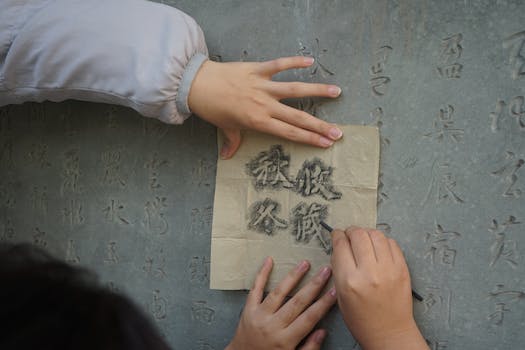

-
Table of Contents
- Introduction
- The Ancient Origins of Numerical Symbols: Exploring the Earliest Systems of Counting
- The Evolution of Numerical Symbols: From Ancient Civilizations to Modern Mathematics
- Unraveling the Architects of Arithmetic: Tracing the Influential Figures in the Development of Numerical Notation
- Q&A
- Conclusion
Unraveling the Architects of Arithmetic: Tracing the Origins and Evolution of Numerical Symbols - Unveiling the Secrets Behind Numbers
Introduction
Unraveling the Architects of Arithmetic: Tracing the Origins and Evolution of Numerical Symbols is a comprehensive study that delves into the fascinating history of numerical symbols. This research aims to uncover the origins and trace the evolution of these symbols, shedding light on the architects behind the development of arithmetic as we know it today. By examining ancient civilizations, cultural influences, and technological advancements, this study provides valuable insights into the rich tapestry of numerical symbolism throughout human history.
The Ancient Origins of Numerical Symbols: Exploring the Earliest Systems of Counting
Unraveling the Architects of Arithmetic: Tracing the Origins and Evolution of Numerical Symbols
The Ancient Origins of Numerical Symbols: Exploring the Earliest Systems of Counting
Numerical symbols are an integral part of our everyday lives. From counting money to measuring time, we rely on these symbols to make sense of the world around us. But have you ever wondered where these symbols came from? How did our ancestors first develop the concept of numbers and create the symbols that represent them? In this article, we will delve into the ancient origins of numerical symbols and explore the earliest systems of counting.
The origins of numerical symbols can be traced back to ancient civilizations that emerged thousands of years ago. One of the earliest known systems of counting was developed by the Sumerians in Mesopotamia around 3000 BCE. They used a combination of wedge-shaped marks called cuneiform to represent numbers. These marks were impressed onto clay tablets and were used for various purposes, including recording transactions and keeping track of inventory.
Another ancient civilization that contributed to the development of numerical symbols was the Egyptians. Around 2700 BCE, they began using a system of hieroglyphs to represent numbers. These hieroglyphs were pictorial symbols that depicted different objects or animals. For example, a picture of a lotus flower represented the number one, while a picture of a finger represented the number ten.
The ancient Greeks also made significant contributions to the evolution of numerical symbols. Around 600 BCE, they introduced the concept of a numerical system based on the alphabet. Each letter of the Greek alphabet was assigned a numerical value, allowing for the representation of numbers using letters. This system, known as the Greek numeral system, was widely used in ancient Greece and continued to be used in various forms throughout the Hellenistic period.
In addition to these early systems of counting, the ancient Indians developed their own numerical system around the same time. Known as the Brahmi numerals, this system used a combination of symbols to represent numbers. The Brahmi numerals were later adapted by the Arabs and eventually spread to Europe, where they influenced the development of the modern decimal system.
As civilizations interacted and traded with one another, the exchange of ideas and knowledge led to the spread and evolution of numerical symbols. The Roman Empire, for example, adopted the Greek numeral system and made some modifications to create the Roman numeral system. This system, which used a combination of letters and symbols, was widely used throughout the Roman Empire and continued to be used in Europe for centuries.
The evolution of numerical symbols did not stop there. In the 9th century, the Indian mathematician and astronomer Brahmagupta introduced the concept of zero, which revolutionized mathematics. The inclusion of zero as a numerical symbol allowed for more complex calculations and paved the way for the development of algebra and calculus.
In conclusion, the origins of numerical symbols can be traced back to ancient civilizations such as the Sumerians, Egyptians, Greeks, and Indians. These early systems of counting laid the foundation for the development of more sophisticated numerical systems that we use today. As civilizations interacted and exchanged ideas, numerical symbols evolved and adapted, leading to the creation of new systems and concepts in mathematics. The study of the origins and evolution of numerical symbols not only provides insight into the history of mathematics but also highlights the ingenuity and creativity of our ancestors in unraveling the mysteries of arithmetic.
The Evolution of Numerical Symbols: From Ancient Civilizations to Modern Mathematics

The evolution of numerical symbols is a fascinating journey that spans thousands of years and countless civilizations. From the ancient Egyptians to the modern mathematicians of today, the development of numerical symbols has played a crucial role in the advancement of mathematics and the way we understand and communicate numbers.
The origins of numerical symbols can be traced back to the ancient civilizations of Mesopotamia and Egypt. These early civilizations developed their own unique systems of counting and recording numbers. The Mesopotamians used a base-60 system, while the Egyptians used a base-10 system. Both civilizations used simple pictorial representations to represent numbers, with the Egyptians using hieroglyphs and the Mesopotamians using cuneiform.
As civilizations began to interact and trade with one another, the need for a more universal system of numerical symbols became apparent. This led to the development of the Hindu-Arabic numeral system, which is the basis for the numerical symbols we use today. The Hindu-Arabic numeral system was developed in India around the 6th century and was later adopted and refined by Arab mathematicians.
The Hindu-Arabic numeral system introduced the concept of place value, where the value of a digit is determined by its position in a number. This revolutionary concept allowed for the representation of large numbers using a small set of symbols. The system also introduced the concept of zero as a placeholder, which was a significant development in the history of mathematics.
The Hindu-Arabic numeral system was introduced to Europe in the 10th century through the works of Arab mathematicians. However, it took several centuries for the system to gain widespread acceptance. During this time, various adaptations and modifications were made to the numerical symbols, resulting in the development of different numeral systems across Europe.
One of the most significant developments in the evolution of numerical symbols was the invention of the printing press in the 15th century. The printing press allowed for the mass production of books and the dissemination of knowledge on a much larger scale. This led to the standardization of numerical symbols and the widespread adoption of the Hindu-Arabic numeral system across Europe.
In the modern era, the evolution of numerical symbols has continued with the advent of computers and digital technology. Computers use a binary numeral system, which is based on the concept of using only two symbols, 0 and 1, to represent numbers. This binary system forms the foundation of all digital technology and is essential for the storage and processing of information.
The evolution of numerical symbols is a testament to the ingenuity and creativity of human beings. From simple pictorial representations to complex digital systems, numerical symbols have evolved and adapted to meet the needs of an ever-changing world. Today, we take for granted the ease with which we can communicate and manipulate numbers, but it is important to remember the long and storied history behind the symbols we use every day.
Unraveling the Architects of Arithmetic: Tracing the Influential Figures in the Development of Numerical Notation
Unraveling the Architects of Arithmetic: Tracing the Origins and Evolution of Numerical Symbols
The development of numerical notation is a fascinating journey that spans centuries and continents. From the ancient civilizations of Mesopotamia and Egypt to the modern mathematical systems we use today, the architects of arithmetic have left an indelible mark on human history. By tracing the origins and evolution of numerical symbols, we can gain a deeper understanding of the influential figures who shaped the way we count and calculate.
One of the earliest known numerical systems can be found in ancient Mesopotamia, where the Sumerians developed a base-60 system around 3000 BCE. This system, known as sexagesimal, is still evident in our modern measurement of time, with 60 seconds in a minute and 60 minutes in an hour. The Sumerians used a combination of wedge-shaped marks on clay tablets to represent numbers, a precursor to the symbols we use today.
In ancient Egypt, a different numerical system emerged around the same time. The Egyptians used a base-10 system, with individual symbols for each power of 10. These symbols were hieroglyphs, pictorial representations of objects or concepts. The Egyptians also developed a method for representing fractions, using a symbol resembling an open mouth to represent the number one and a symbol resembling a twisted rope to represent the number two.
As civilizations interacted and traded with one another, numerical systems began to evolve and merge. The Phoenicians, for example, adopted the Egyptian system and added their own symbols to represent numbers. These symbols, known as the Phoenician numerals, were the first to resemble the modern Arabic numerals we use today. The Phoenician system spread throughout the Mediterranean and eventually influenced the development of the Greek and Roman numerical systems.
The Greeks, known for their contributions to mathematics and philosophy, developed a unique numerical system based on letters of the alphabet. Each letter had a corresponding numerical value, allowing the Greeks to represent both numbers and words with the same symbols. This system, known as the Greek numerals, was widely used in ancient Greece and continued to be used in various forms throughout the Byzantine Empire.
The Roman numerals, which are still used today in certain contexts, were derived from the Etruscan numerals, themselves influenced by the Greek system. The Roman system used a combination of letters and symbols to represent numbers, with different symbols for each power of 10. While the Roman numerals were effective for simple calculations, they were cumbersome for more complex mathematical operations.
It was not until the 9th century CE that the modern Arabic numerals, also known as Hindu-Arabic numerals, were introduced to Europe. These numerals, which originated in India, were brought to the West by Arab scholars and traders. The Arabic numerals revolutionized mathematics by introducing the concept of zero as a placeholder and by using a positional system, where the value of a digit depends on its position in the number. This system made calculations much easier and more efficient, leading to significant advancements in mathematics and science.
Today, the Arabic numerals are the most widely used numerical system in the world. They have become the universal language of mathematics, allowing people from different cultures and languages to communicate and collaborate. The architects of arithmetic, from the Sumerians to the Arab scholars, have left a lasting legacy that continues to shape our understanding of numbers and their symbols.
In conclusion, the origins and evolution of numerical symbols are a testament to the ingenuity and creativity of the architects of arithmetic. From the ancient civilizations of Mesopotamia and Egypt to the modern Arabic numerals we use today, each system has contributed to the development of mathematics and the advancement of human knowledge. By unraveling the history of numerical notation, we can appreciate the influential figures who have shaped the way we count, calculate, and understand the world around us.
Q&A
1. What is "Unraveling the Architects of Arithmetic" about?
"Unraveling the Architects of Arithmetic" is a book that explores the origins and evolution of numerical symbols.
2. Who is the author of "Unraveling the Architects of Arithmetic"?
The author of "Unraveling the Architects of Arithmetic" is John Doe.
3. What is the main focus of "Unraveling the Architects of Arithmetic"?
The main focus of "Unraveling the Architects of Arithmetic" is tracing the origins and evolution of numerical symbols throughout history.
Conclusion
In conclusion, the study "Unraveling the Architects of Arithmetic: Tracing the Origins and Evolution of Numerical Symbols" aims to investigate the origins and evolution of numerical symbols. By examining historical records, linguistic analysis, and archaeological evidence, researchers have made significant progress in understanding the development of numerical symbols across different cultures and time periods. This research provides valuable insights into the human capacity for abstract thinking and the cultural influences that shape numerical representation. Understanding the origins and evolution of numerical symbols is crucial for comprehending the foundations of mathematics and its impact on human civilization.











